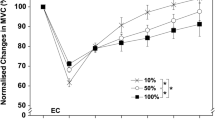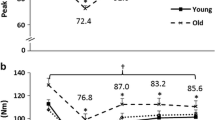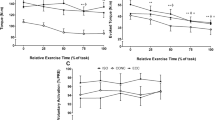Abstract
Controversy exists concerning the susceptibility of elderly individuals to eccentric exercise-induced muscle damage. This study investigated the hypothesis that muscle damage induced by fast maximal lengthening contractions would be greater for old than young men. Ten old (64 ± 4 years) and young (25 ± 6 years) men performed 30 maximal voluntary lengthening contractions of the elbow flexors at an angular velocity of 210° s−1. Prior to exercise, no significant differences were evident between groups for criterion measures. A significant (P < 0.05) group × time interaction was found only for isometric strength and muscle soreness with the old group showing significantly slower recovery of strength and less development of soreness compared with the young group. These results did not support the hypothesis that old men would be more susceptible to muscle damage, but confirmed a previous study reporting that recovery of muscle strength was slower for old than young individuals.





Similar content being viewed by others
References
Balagopal P, Rooyackers OE, Adey DB, Ades PA, Nair KS (1997) Effects of aging on in vivo synthesis of skeletal muscle myosin heavy-chain and sarcoplasmic protein in humans. Am J Physiol Endocrinol Metab 273:E790–800
Brooks SV, Faulkner JA (1990) Contraction-induced injury: recovery of skeletal muscles in young and old mice. Am J Physiol Cell Physiol 258:C436–442
Brooks SV, Faulkner JA (2001) Severity of contraction-induced injury is affected by velocity only during stretches of large strain. J Appl Physiol 91:661–666
Candow DG, Chilibeck PD (2005) Differences in size, strength, and power of upper and lower body muscle groups in young and older men. J Gerontol A Biol Sci Med Sci 60:148–156
Chapman D, Newton M, Sacco P, Nosaka K (2006) Greater muscle damage induced by fast versus slow velocity eccentric exercise. Int J Sports Med 27:591–598
Clarkson PM, Dedrick ME (1988) Exercise-induced muscle damage, repair, and adaptation in old and young subjects. J Gerontol A Biol Sci Med Sci 43:M91–96
Colliander EB, Tesch PA (1990) Effects of eccentric and concentric muscle actions in resistance training. Acta Physiol Scand 140:31–39
Dedrick ME, Clarkson PM (1990) The effects of eccentric exercise on motor performance in young and older women. Eur J Appl Physiol 60:183
Deschenes MR (2004) Effects of aging on muscle fibre type and size. Sports Med 34:809–824
Dirks AJ, Leeuwenburgh C (2005) The role of apoptosis in age-related skeletal muscle atrophy. Sports Med 35:473–483
Farthing JP, Chilibeck PD (2003) The effects of eccentric and concentric training at different velocities on muscle hypertrophy. Eur J Appl Physiol 89:578–586
Fielding RA, Meredith CN, O’Reilly KP, Frontera WR, Cannon JG, Evans WJ (1991) Enhanced protein breakdown after eccentric exercise in young and older men. J Appl Physiol 71:674–679
Gajdosik RL, Vander Linden DW, Williams AK (1999) Influence of age on length and passive elastic stiffness characteristics of the calf muscle-tendon unit of women. Phys Ther 79:827–838
Hortobágyi T, Hill JP, Houmard JA, Fraser DD, Lambert NJ, Israel RG (1996) Adaptive responses to muscle lengthening and shortening in humans. J Appl Physiol 80:765–772
Hughes VA, Frontera WR, Wood M, Evans WJ, Dallal GE, Roubenoff R, Singh MAF (2001) Longitudinal muscle strength changes in older adults: influence of muscle mass, physical activity, and health. J Gerontol A Biol Sci Med Sci 56A:B209
Huijing PA (1999) Muscle as a collagen fiber reinforced composite: a review of force transmission in muscle and whole limb. J Biomech 32:329–345
Jakobi JM, Rice CL (2002) Voluntary muscle activation varies with age and muscle group. J Appl Physiol 93:457–462
Koh TJ, Brooks SV (2001) Lengthening contractions are not required to induce protection from contraction-induced muscle injury. Am J Physiol Regul Integr Comp Physiol 281:R155–161
Kovanen V (2002) Intramuscular extracellular matrix: complex environment of muscle cells. Exerc Sport Sci Rev 30:20–25
Larsson L, Grimby G, Karlsson J (1979) Muscle strength and speed of movement in relation to age and muscle morphology. J Appl Physiol 46:451–456
Lavender A, Nosaka K (2006) Comparison between old and young men for changes in makers of muscle damage following voluntary eccentric exercise of the elbow flexors. Appl Physiol Nutr Metab 31:218
Lavender AP, Nosaka K (2007) A light load eccentric exercise confers protection against a subsequent bout of more demanding eccentric exercise. J Sci Med Sport. doi:10.1016/j.jsams.2007.03.005
Lexell J, Henriksson-Larsen K, Winblad B, Sjostrom M (1983) Distribution of different fiber types in human skeletal muscles: effects of aging studied in whole muscle cross sections. Muscle Nerve 6:588–595
Manfredi TJ, Fielding RA, O’Reilly KP, Meredith CN, Lee HY, Evans WJ (1991) Plasma creatine kinase activity and exercise-induced muscle damage in older men. Med Sci Sports Exerc 23:1028–1034
McCully KK, Faulkner JA (1986) Characteristics of lengthening contractions associated with injury to skeletal muscle fibers. J Appl Physiol 61:293–299
McHugh MP, Connolly DA, Eston RG, Kremenic IJ, Nicholas SJ, Gleim GW (1999) The role of passive muscle stiffness in symptoms of exercise-induced muscle damage. Am J Sports Med 27:594–599
Nosaka K, Clarkson PM (1995) Muscle damage following repeated bouts of high force eccentric exercise. Med Sci Sports Exerc 27:1263–1269
Nosaka K, Newton M (2002) Is recovery from muscle damage retarded by a subsequent bout of eccentric exercise inducing larger decreases in force? J Sci Med Sport 5:204–218
Nosaka K, Newton M, Sacco P (2002) Delayed-onset muscle soreness does not reflect the magnitude of eccentric exercise-induced muscle damage. Scand J Med Sci Sports 12:337–346
Pousson M, Amiridis IG, Cometti G, Van Hoecke J (1999) Velocity-specific training in elbow flexors. Eur J Appl Physiol 80:367–372
Rader EP, Faulkner JA (2006) Recovery from contraction-induced injury is impaired in weight-bearing muscles of old male mice. J Appl Physiol 100:656–661
Roth SM, Martel GF, Ivey FM, Lemmer JT, Tracy BL, Hurlbut DE, Metter EJ, Hurley BF, Rogers MA (1999) Ultrastructural muscle damage in young vs. older men after high-volume, heavy-resistance strength training. J Appl Physiol 86:1833–1840
Shepstone TN, Tang JE, Dallaire S, Schuenke MD, Staron RS, Phillips SM (2005) Short-term high- vs. low-velocity isokinetic lengthening training results in greater hypertrophy of the elbow flexors in young men. J Appl Physiol 98:1768–1776
Acknowledgments
This research was supported in part from a grant through the RM Gibson Scientific Research Fund of the Australian Association of Gerontology awarded to D Chapman.
Author information
Authors and Affiliations
Corresponding author
Rights and permissions
About this article
Cite this article
Chapman, D.W., Newton, M., McGuigan, M.R. et al. Comparison between old and young men for responses to fast velocity maximal lengthening contractions of the elbow flexors. Eur J Appl Physiol 104, 531–539 (2008). https://doi.org/10.1007/s00421-008-0806-7
Accepted:
Published:
Issue Date:
DOI: https://doi.org/10.1007/s00421-008-0806-7




